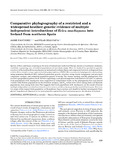Mostrar o rexistro simple do ítem
Comparative Phylogeography of a Restricted and a Widespread Heather: Genetic Evidence of Multiple Independent Introductions of Erica Mackayana Into Ireland From Northern Spain
| dc.contributor.author | Fagúndez, Jaime | |
| dc.contributor.author | Díaz-Tapia, P. | |
| dc.date.accessioned | 2023-03-24T10:54:36Z | |
| dc.date.available | 2023-03-24T10:54:36Z | |
| dc.date.issued | 2023-01-20 | |
| dc.identifier.citation | Jaime Fagúndez, Pilar Díaz-Tapia, Comparative phylogeography of a restricted and a widespread heather: genetic evidence of multiple independent introductions of Erica mackayana into Ireland from northern Spain, Botanical Journal of the Linnean Society, Volume 201, Issue 3, March 2023, Pages 329–340, https://doi.org/10.1093/botlinnean/boac071 | es_ES |
| dc.identifier.issn | 1095-8339 | |
| dc.identifier.uri | http://hdl.handle.net/2183/32759 | |
| dc.description | Financiado para publicación en acceso aberto: Universidade da Coruña/CISUG | es_ES |
| dc.description.abstract | [Abstract] Species of flora and fauna occurring in the west of Ireland and south-west Europe, known as Lusitanian elements, constitute a puzzling case of isolated populations of uncertain origin. Here we studied the population genetic structure of the heather Erica mackayana in Ireland and northern Spain and compared it with its widespread close relative Erica tetralix using single nucleotide polymorphisms (SNPs). We reconstructed phylogenetic relationships using maximum likelihood (ML), inferred population genetic structure using cluster assignment and principal component analysis, and estimated population genetic diversity. The cluster analysis and ML phylogenetic tree showed a geographical pattern for E. tetralix supporting a post-glacial migration from Iberia to Ireland. In contrast, Irish populations of E. mackayana were supported in independent clades in the phylogenetic tree and shared clusters with Iberian populations in the structure analysis, and FST values were lower among Irish and Spanish populations than among Irish ones. This suggests that Irish populations of E. mackayana are the result of recent multiple independent introductions from its native area in northern Spain, probably assisted by humans. However, the origin of the largest Irish population at Roundstone Bog is unclear and should be further investigated. Post-glacial, long-distance dispersal is the most plausible explanation for Lusitanian species distribution in Ireland. | es_ES |
| dc.description.sponsorship | This work was partially supported by Xunta de Galicia ‘Talento Senior’ (grant 03IN858A2019-1630129) to P.D-.T. and ‘Axudas para a consolidación e estruturación de unidades de investigación competitivas do SUG’ (grants ED431D 2017/20, ED431B 2018/49). Funding for open access charge: Universidade da Coruña/CISUG | es_ES |
| dc.description.sponsorship | Xunta de Galicia; 03_IN858A_2019_1630129 | es_ES |
| dc.description.sponsorship | Xutna de Galicia; ED431D 2017/20 | es_ES |
| dc.description.sponsorship | Xunta de Galicia; ED431B 2018/49 | es_ES |
| dc.language.iso | eng | es_ES |
| dc.publisher | The Linnean Society of London | es_ES |
| dc.relation.uri | https://doi.org/10.1093/botlinnean/boac071 | es_ES |
| dc.rights | Atribución-NoComercial-SinDerivadas 4.0 Internacional | es_ES |
| dc.rights.uri | http://creativecommons.org/licenses/by-nc-nd/4.0/ | * |
| dc.subject | Erica tetralix | es_ES |
| dc.subject | Hiberno-Iberian species | es_ES |
| dc.subject | Lusitanian species | es_ES |
| dc.subject | SNPs | es_ES |
| dc.title | Comparative Phylogeography of a Restricted and a Widespread Heather: Genetic Evidence of Multiple Independent Introductions of Erica Mackayana Into Ireland From Northern Spain | es_ES |
| dc.type | info:eu-repo/semantics/article | es_ES |
| dc.rights.access | info:eu-repo/semantics/openAccess | es_ES |
| UDC.journalTitle | Botanical Journal of the Linnean Society | es_ES |
| UDC.volume | 201 (2023) | es_ES |
| UDC.issue | 3 (March) | es_ES |
| UDC.startPage | 329 | es_ES |
| UDC.endPage | 340 | es_ES |
| dc.identifier.doi | 10.1093/botlinnean/boac071 |






